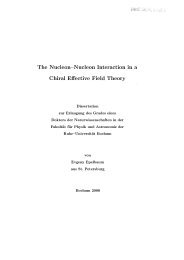t Hooft mechanism of confinement or dual Meissner effect
t Hooft mechanism of confinement or dual Meissner effect
t Hooft mechanism of confinement or dual Meissner effect
Create successful ePaper yourself
Turn your PDF publications into a flip-book with our unique Google optimized e-Paper software.
Monopole interactions<br />
One can add up (anti)monopoles only in the singular (‘stringy’) gauge where the Higgs<br />
field φ a r→∞<br />
−→ δ a3 v.<br />
The interaction <strong>of</strong> two (anti)monopoles is Coulomb-like at large separations:<br />
U int = 4π 1 (<br />
)<br />
±1 − e −r 12 m H .<br />
g 2 r 12<br />
Two gluons (out <strong>of</strong> three) W ± = A1 √±iA 2<br />
2<br />
have large masses m W = gv and decouple.<br />
The third gluon (the ‘photon’) is massless, but there are monopoles around.<br />
Monopole ensemble<br />
Monopole ‘weight’ <strong>or</strong> ‘fugacity’<br />
ζ = (pre−exponent) · exp(−Action) = controllably small.<br />
At small momenta, the the<strong>or</strong>y becomes the the<strong>or</strong>y <strong>of</strong> plasma <strong>of</strong> magnetic charges <strong>of</strong><br />
Confinement in the 3d Ge<strong>or</strong>gi–Glashow model D. Diakonov, L-12












